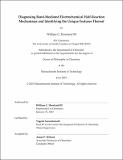Diagnosing Band-Mediated Electrochemical Half-Reaction Mechanisms and Identifying the Unique Features Thereof
Author(s)
Howland III, William C.,
DownloadThesis PDF (16.69Mb)
Advisor
Surendranath, Yogesh
Terms of use
Metadata
Show full item recordAbstract
Redox catalysis is pervasive in both benchtop and industrial scale chemistry as a means of introducing and interconverting between key functional groups as well as, increasingly, a means to elaborate carbon skeletons. Further development of redox catalysis methods is of central importance as we seek to eliminate the use of environmentally harmful reagents, reduce volumes of chemical waste by improving atom economy, and enable new means of functionalizing small molecule feedstocks and modifying heavily functionalized biomass feedstocks. Despite the centrality of redox catalysis to both contemporary and future chemistry, a unified understanding of its principles has to this point not been synthesized by the community. Redox catalysis is approached from two directions that do not, for the most part, communicate with one another: thermal redox and electrochemical redox. Thermal redox is concerned with the use of purely chemical processes to effect transformations while the application of electrochemical understanding of redox is generally limited to electrolysis in the context of chemical synthesis. This work seeks to bridge these disparate areas of redox chemistry by demonstrating that thermal redox catalysis on heterogeneous catalysts may proceed by electrochemical mechanisms. Furthermore, we aim to illustrate the distinctive characteristics of this reactivity paradigm in the hope that the unique features might be exploited in future redox catalyst design.
In Chapter 2, we show that thermal oxidation of an organic reactant on a doped carbon catalyst with molecule-like active sites appears to proceed by electrochemical half-reactions mediated by the conduction band of the catalyst.
In Chapter 3, we develop mathematical models to rationalize and predict catalyst behavior in non-ideal band-mediated electrochemical catalysis with particular emphasis on the effects of resistivity and the possible modes of interference between half-reactions.
In Chapter 4, we seek to identify manifestations of cooperativity between the grains of polycrystalline platinum in the form of electrical charge transfer between grains of different relative activity towards the constituent half-reactions of aerobic formic acid oxidation.
This thesis is intended to serve as a prompt and a guide to the further exploration of thermal redox catalysis proceeding by band-mediated electrochemical half-reactions. It is hoped that this work represents a substantial step toward the exploitation of the unique capacity of band-mediated mechanisms to catalyze each individual half-reaction on spatially and chemically distinct moieties that may be independently optimized for their specialized purpose and to autonomously and optimally apportion overall driving force between the reactions. More broadly, it is hoped that this work contributes to the application of electrochemical understandings and methods to thermal catalysis.
Date issued
2023-06Department
Massachusetts Institute of Technology. Department of ChemistryPublisher
Massachusetts Institute of Technology